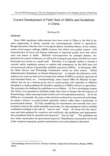Current Development of Field Tests of GMOs and Guidelines in China
JIRCAS international symposium series
| ISSN | 13406108 |
|---|---|
| 書誌レコードID(総合目録DB) | AA1100908X |

本文フルテキスト
intlsymp-5_137-144.pdf221.2 KB
Since 1986, significant achievements have been made in China in the field of genetic engineering of plants, animals and microorganisms related to agriculture. Rough estimation indicates that 15 transgenic plants, including tobacco, cotton, tomato, potato, sweet pepper, cabbage, alfalfa, soybean, rice, wheat, corn, poplar, papaya with characteristics of insect and disease resistance or improved quality have been developed and tested in fields. Modified microorganisms for nitrogen fixation, biopesticides for control of diseases, as well as the transgenic pig, sheep and fish have been developed and tested on a small scale. Therefore, it is urgently needed to develop a national safety regulation system to conduct risk assessment on the field tests and environmental release of genetically modified organisms (GMOs). In December 1993, the State Science and Technology Commission issued an order named "Safety Administration Regulation on Genetic Engineering" to regulate the laboratory work, medium-size scale-up tests and environmental release of GMOs in medical, agricultural and industrial fields, etc. Correspondingly, since August 1994, the Ministry of Agriculture has set up a leading group and an expert group, with expertise in different disciplines to draft guidelines for biosafety regulation of GMOs relevant to agriculture. The principles for drafting the guidelines are as follows: (1) For a developing country like China, it is important to facilitate rather than limit or hamper the development of biotechnology, while ensuring human health and environmental protection. (2) As the GMOs are, in principle, the same as the products produced by conventional technology, we adopt a science- or product-based regulation system rather than a technology- or process-based system. (3) Fully considering the experiences and scientific data accumulated to-date in the world scientific community, the risk assessment will be carefully conducted according to the rule of "case by case" study. (4) Along with the experience and data gathered by ourselves and worldwide, the guidelines and implementation procedures shall be amended and improved "step by step". The guidelines are now under examination for government approval. Classification of potential risk levels of the recipient organisms, genetic manipulation and end-products is described.
| 作成者 | Shi-Rong JIA |
|---|---|
| 公開者 | Japan International Research Center for Agricultural Sciences |
| オンライン掲載日 | |
| 号 | 5 |
| 開始ページ | 137 |
| 終了ページ | 144 |
| 言語 | eng |
